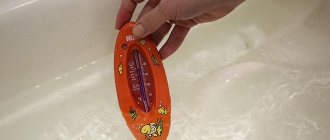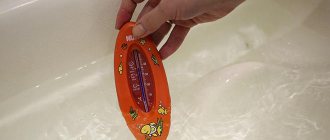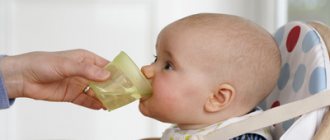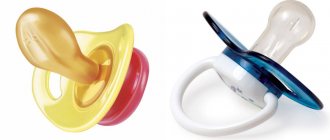Bathing a newborn baby is a mandatory event that takes place almost the next day after discharge from the hospital and is repeated daily for at least six months. Of course, new parents, whether they are new parents or not, always approach this important event with caution and caution. If mothers receive some information about how to bathe, what to pour into the water and what temperature, in fact, it should be in the hospital, then the question of how to protect the baby’s ears from getting water and whether this is necessary is often becomes a real cornerstone in the process of raising young children. Is it possible to wet a child’s ears and what to do if water gets into a newborn’s ear - these and similar questions often worry parents of infants. Therefore, today we are talking about exactly this: water got into the ear of a newborn: what to do?
The most common first reaction when water gets into a newborn's ear is panic. The reason for such an inadequate reaction is elementary ignorance of the physiological structure of the ear of a small child and the influence of previously heard or read stories, stories and tales from a series of horror stories. Today, medical institutions have recorded a huge number of calls with this type of treatment: water got into the ear of a newborn. And parents, in most such cases, solely believe that water can cause such serious consequences as: swelling of wax plugs, the formation of inflammatory processes that negatively affect hearing and even provoke its complete loss. Therefore, in order to prevent such a development of events, many, often even pediatricians, argue that in order to prevent water from getting into the newborn’s ear, you need to use caps, headphones and cotton swabs. Is this so? Let’s find out in more detail!
What you need to know!
If water gets into a newborn’s ear, the situation is absolutely normal and natural if you know that:
The ear of a newborn is significantly different from the ear of an adult. If you and I have an ear canal that is long, branched and curved, then little children also have these curls, but they are shorter and smaller, and they are also located at right angles from the sink, so water that gets into the ear instantly and unhindered flows out .
Moreover, it is recommended to bathe the baby in such a way that his ears are in the water so that water can penetrate into them. This may seem absurd, but it is considered necessary for cleaning and hardening the ears.
There is a plug of wax in the babies' ears, which protected his ears from water penetration the entire time he was in his mother's tummy. So this plug persists for some time after birth, so it is not common for a breastfed child to be afraid of water at all.
What not to do if water gets into a newborn’s ear.
Has water gotten into your newborn's ear? There is absolutely nothing wrong with this. Other, sometimes even incredible and stupid, manipulations by parents are much more dangerous for children’s ears:
- using cotton swabs after bathing to extract excess moisture and sulfur;
- drying ears with a hairdryer;
- warming up with a hot heating pad;
- use of a medical bulb;
- blowing water;
- and even the shaking of a newborn.
Such actions by parents can seriously harm the baby and negatively affect his health.
What to do if water gets into a newborn’s ear.
After bathing your newborn, all you need to do is:
Wipe his ears dry with regular cotton wool using gentle, non-sharp movements. The best way to do this is to make something like a flagellum out of cotton wool and carefully insert part of it with rotational movements into the child’s ear.
In addition, swimming instructors for children and pediatricians recommend that after bathing the baby, simply turn it over first to one side and then to the other. You can put the baby on its side on a dry diaper, wait a couple of minutes, and then put it on another side so that the water spontaneously flows out of the newborn’s ear.
You can also use heat. Place the baby on a warm pillow, blanket, blanket or use a heating pad, but only warm, not hot. You can make a compress. To do this, you need to moisten a large piece of cotton wool, gauze or cloth with vodka, make a hole in it, place it on the area around the ear, so that the shell of the ear falls into the hole and remains uncovered. Then cover everything with plastic and a warm blanket on top, place the child on his side with his ear down and wait a few minutes.
It is very important, especially in the winter, if the room in which the baby is after bathing is cool and ventilated, put a light hat on him. This is necessary so that over time, cooled water that gets into the ears does not provoke the development of inflammatory processes and infections.
When water gets into the ear it can be dangerous.
If water gets into a newborn’s ear immediately after he has suffered from a cold or, even worse, an ear disease, it is necessary to get rid of it as quickly as possible. If a newborn has recently had otitis media, water getting into the ear can really harm him. If the methods listed above for getting rid of water from the ear did not help, the child behaves inappropriately: he is capricious, refuses to eat, cries, especially hard when trying to take the breast or bottle into his mouth, immediately contact an otolaryngologist.
To prevent water from getting into the ear of a child who has recently suffered from otitis media, it is better to try to protect his ears from water for some time. To do this, before bathing, you can insert cotton swabs into your ears, previously lubricated with baby cream or Vaseline.
Water is the natural habitat for a newborn. Remember that your baby stayed in it for 9 months and didn’t need any tampons or caps, so you shouldn’t somehow cover and protect his ears from water while bathing. It’s another matter if we are talking about a child who has recently had otitis media. In most cases, water that gets into a newborn’s ear comes out on its own, without causing him any inconvenience or problems. If water does get into your newborn’s ear, don’t panic, try to get rid of it using the methods suggested above, and if the baby behaves inappropriately, seek help from a professional. Remember that a calm attitude and a sober mind in any situation is half the success in solving a problem!
The process of bathing a baby in the evening is, of course, the most fun and active pastime for a baby, but for inexperienced parents, this positive daily procedure is sometimes accompanied by great experiences when they are lost and do not know what to do.
The baby may swallow soapy water, hit his head on the side of the bathtub while “swimming” in his lap - these, in principle, normal little things for children of the first year sometimes make parents seriously worry. Moms and dads are no less worried about episodes when their baby gets water in his ear while bathing. Are such situations dangerous, and how should parents behave?
About the structure of a baby's ears
For many adults, water that gets into the ears while swimming causes a lot of inconvenience, ranging from temporary congestion to serious inflammatory processes. When soaking, we immediately feel it and know what to do - we strive to rid the “affected” ear of moisture, so that later we do not suffer from the serious consequences that water that gets into the auditory organs will bring us.
That is why inexperienced parents are very worried when they notice that during water procedures the baby has wet even one ear, and immediately begin to look for a solution on the Internet or torment doctors in the hope of finding out what to do.
In fact, the structure of the ears of adults and infants has significant differences.
- Our auditory canals are very long and have many bends and branches. Sulfur masses are retained in them, swelling when water gets on them, or inflammatory processes begin due to the influence of the liquid.
- In infants, these curls are not so pronounced, and the passages are shorter and located almost at right angles to the auricle. If water gets into the ear of a newborn or older baby while bathing, it will come out freely.
Don’t be afraid to wet your newborn’s ears—the baby still has wax plugs that protected the ear canals during the prenatal period from amniotic fluid getting into them. They gradually “wash out” and move out of the baby’s ears.
Experts even recommend bathing infants so that each ear is simultaneously covered with water - this improves the cleaning of the ear canals from wax and dead epidermal cells. Also, exposure to moisture has a hardening effect on babies’ ears.
What not to do?
Water getting into a baby's ear poses virtually no threat to him, but still such episodes require attention and correct, adequate actions from parents. The following must not be done:
- Dry the baby's ear canals soaked in water with a hairdryer. Hot and drying air can lead to inflammation and death of the epithelium.
- Warm your baby's ears with a heating pad.
- “Blot” the soaked ear canals with cotton swabs, plunging them deep into the ear.
- Use a syringe to remove moisture from the ear canals;
- Shake the baby so that water flows out of his ears.
We react correctly
- At the end of bathing, it is enough to blot the baby’s ears with a cotton pad or a thick cotton ball;
- if you think that you need to blot the newborn’s ears deeper, you can roll up a flagellum of cotton wool and insert it shallowly - no more than 0.5 cm - into the baby’s ear canals;
- after bathing the baby, if he dived a lot or his ears were immersed in water, you can alternately turn him on his sides so that the liquid that gets in flows freely onto a towel or diaper;
- If water gets into the baby's ear canals, so that it does not provoke inflammatory processes, especially in the cold season, after bathing, you need to put a cap or cap on the newborn's head to cover the ears.
If the baby has had otitis media or has recently had a cold, it is better not to take risks and protect his ears so that water does not get into the ear canals.
To close the baby's ear canals during bathing, you can use:
- special silicone plugs;
- ordinary cotton balls, which should be lightly lubricated with Vaseline or baby cream;
- You can put a rubber cap on the newborn’s head, which will prevent moisture from getting into his ears.
If these measures did not help, and after a cold or otitis media the baby behaves capriciously, touches the ear, does not want to eat, sleeps restlessly, and when pressing on the tragus begins to cry, immediately consult an ENT specialist. Even if you already know how to cope with the disease, you still need examination and consultation with a specialist.
Even ordinary hygiene procedures raise a lot of unexpected questions from parents when it comes to a newborn baby. Let's try to figure out whether it is possible to wet a baby's ears, and what to do if water gets into the baby's ear.
In what cases should you consult a doctor?
For children with weakened immune systems due to a recent cold or ear infection, water getting into the ear can be dangerous. In this case, if water gets into the newborn’s ear, it is better to contact an otolaryngologist, especially if otitis media was suffered no more than 3 months ago. Also, liquid should not be allowed to enter the auditory cavity if the room temperature is less than 18 degrees. In this case, hypothermia can cause the development of an inflammatory process.
If liquid that enters the baby's ear canal while bathing becomes a cause for concern, the baby should be shown to a doctor. Discomfort and pain, which the child expresses through screams and crying, can manifest itself after liquid ingress, against the background of a pathological process occurring in a latent form. It is possible to exclude the possibility of developing otitis media, which poses a sufficient danger to the newborn, after an in-person examination and laboratory examination.
Is it possible to wet a newborn?
The human hearing aid has a rather complex structure. Probably every adult knows the unpleasant sensation when water penetrates into the ears while swimming and is present somewhere inside for a long time, causing noticeable discomfort. Of course, no parent would want their baby to experience such an unpleasant sensation. And many grandmothers also scare new mothers with the danger of inflammation - otitis media. Therefore, when bathing newborn babies, it is customary to take special care - protect the ears with cotton wool and make sure that water does not get on them under any circumstances.
But doctors are confident that such precautions are completely unnecessary. Newborn babies do not yet have a very developed hearing system; in particular, they have a rather short ear canal, which is also at a different angle than that of an adult.
If water gets into the baby's ears, it easily flows out without causing discomfort.
Before birth, children are in an aquatic environment (amniotic fluid). While the fetus is developing, special wax plugs form in its ears. They protect the hearing aid from too deep water penetration. Such traffic jams disappear after some time. But in any case, the newborn’s ears are well protected from deep penetration of liquid. Pediatricians and infant swimming specialists know this well. There are methods that involve teaching tiny children to dive, and their ears are not harmed in any way, although they are not protected from water.
Bathing, which involves getting water into a newborn's ears, can be an important part of hardening. And many ENT specialists claim that such a procedure is also necessary for natural cleaning of the ears.
Newborn ears when bathing: should they be covered or can they be wetted?
During the first bath of a newborn baby, every mother has a question - what to do with the ears ? Is it harmful if water gets ? How will the child himself react? We decided to look for answers to all these questions together with you.
Almost every person knows that the ear is an organ with a complex structure. And of course, all adults know the feeling when, when bathing, water gets into the ear and bothers us for a long time.
Of course, every young parent is afraid that his baby will suffer, so many try to completely avoid getting water into their children's ears .
Is it really that scary, let's find out!
Of course, the answer will be: “No, it’s not scary!” A newborn has a special structure of the hearing aid , which is not yet fully formed. The auditory canal is still shorter than that of an adult, and is located at a different angle, which allows any liquid that suddenly enters to flow out freely without remaining inside.
Since the baby spent 9 months actually in water, a special cerumen plug , which at first does not allow the liquid to flow too deeply. Over time, due to exposure to water and many other factors, it disappears. But there is no need to worry about water getting into the ear.
First of all, because of the popular opinion (in the form of advice from grandmothers) that water causes otitis media or ARVI . This is wrong!
- Otitis is an inflammation of the middle ear, which is completely independent of getting the ears wet.
- ARVI also does not arise from this factor, but from infections.
There is no need to focus on this issue. fall in love with water as quickly as possible and learn to behave in it. To do this, you don’t need to be afraid that water will get anywhere.
However, there are certain times when a child should still plug his ears . This should be done in cases where the baby has just suffered from ARVI or otitis media. In this case, the doctor will recommend the most suitable method of protection against water - cotton swabs with baby cream, or some other remedy.
Special products for children
Special products are often used to bathe babies . In the first days of life - all kinds of hammocks and slides to support the body; for older children (from 3 months) you can already use hats and circles .
a swimming cap yourself - you need to sew several pieces of foam into the fabric and place them evenly around a regular cap. This design will allow the child not to dive “completely” , and will teach him to stay on the water.
It will also help keep your ears from getting too wet. When immersing yourself in a large bath, it is also recommended to use a neck circle .
This inflatable device helps the child both learn to swim and float on the water, and
will save him from diving and getting water into his eyes and ears .
The most convenient devices for bathing newborns Means for bathing newborns: choosing what you need A hammock for bathing: is it necessary and how to choose A slide for bathing newborns: at what age is it needed, which is better, reviews A circle for bathing newborns: everything you need to know At a minimum , no need to panic. As it gets in, it will flow out . While bathing, it is simply impossible not to get the ears wet, especially if the child enjoys the process and loves to frolic and splash.
For a baby, water is a natural habitat; it should be as comfortable as possible. And if parents start rushing to wipe their ears , then the child’s mood will definitely be ruined, which is still better to avoid! If the baby is already calmly splashing around in the bathtub (or bathtub), then you need to allow him to enjoy it as much as possible.
After finishing the washing process, you just need to blot your ears with a towel , and if necessary, wipe the auricle with a cotton swab or cotton wool . This must be done extremely carefully, trying not to insert it deeply, so as not to damage the eardrum.
If you are absolutely sure that there is a lot of water in the ears, wrap the baby’s head in a towel and turn it on each side in turn (for several minutes) so that excess liquid drains out .
IMPORTANT! You should not go deep into your child’s ears, even if it seems to you that there is a lot of earwax there. If you are afraid to clean your baby’s ears with regular cotton swabs, buy baby swabs; the cotton swab is wound on them in such a way that when cleaning the ears, the swab will not go far under any circumstances!
- Shake the baby;
- Dry your ears with a hairdryer;
- Rub the ear canals vigorously with a towel or cotton wool;
- Insert the cotton swab deeply;
- Warm your head and ears with a heating pad.
Many experts insist that it is even necessary to soak the ears in water - for additional hardening.
What to do if your ears get wet?
If your baby's ears look wet after bathing, and there is a suspicion that water has entered the ear canal, there is definitely no need to be nervous. Recommended:
- Wipe the baby's ears with an ordinary cotton swab (you cannot use an ordinary cotton swab, as it can easily injure the delicate skin).
- Turn the baby over on one side after bathing, and soon on the other. This is very convenient to do during breastfeeding - first attach the baby to one breast, and then to the second. As a result of such a simple change in body position, water will be able to spontaneously flow out of the ear, and sucking movements will only contribute to this.
A baby with wet ears should not be in a cool or drafty environment. But there is no need to specifically warm your ears or wear a tighter cap.
What to do if water gets into your child’s ear while bathing
During the daily bathing of the baby, water may get into his ear; this phenomenon is not a significant cause for concern, but the mother should familiarize herself with the algorithm of actions in this case in advance:
- The newborn's ear canal should be dried using a small piece of cotton wool or gauze. The moisture-absorbing material is inserted into the child’s ear canal (shallowly).
- To speed up the process of fluid leakage, the child should be turned from side to side in a lying position after bathing.
- Heat will help dry out any remaining water in the ear. The child should be placed in a warm room and wrapped in a blanket. The child should be placed on his side, from which side water flows into the ear.
After water procedures in the cool season, the child should wear a textile cap indoors. This simple rule will help prevent the development of inflammatory processes against the background of hypothermia.
Some sources recommend applying an alcohol compress to the baby's ear in order to speed up the process of removing fluid. This technique is unacceptable and can cause dangerous complications.
What can't you do?
Many parents, fearing for the baby’s health, make fairly typical mistakes when trying to remove water from their children’s ears. In particular, doctors warn that it is better:
- Do not use regular cotton swabs or matches with cotton wool wrapped around them.
- Do not dry your ears with a hairdryer (regardless of the speed of the device and its power).
- Do not warm your ears with compresses, heating pads, etc.
- Do not try to extract water with a blower.
- Do not blow out the liquid with your mouth or suck it out.
- Don’t be a coward when trying to get rid of water (in fact, such cases do occur).
If water gets into a baby's ears, it would be most prudent to adhere to non-intervention tactics. Excessive activity and turmoil can cause a lot of harm.
When can it be dangerous?
Sometimes a baby’s ears really need to be carefully protected from water:
- After suffering from acute respiratory viral infection or other diseases. Doctors usually advise not to bathe babies during illness, and after recovery - to take care of their ears.
- In the first couple of weeks after otitis. It is in such a situation that it would be useful to place cotton wool pads lubricated with Vaseline in the baby’s ears. You can also use a special thick cap. The bathing itself should be short and only hygienic, but not recreational.
- At low temperatures in the room where the bath is located or where the child will subsequently be located.
Thus, protecting your baby’s ears from water only makes sense in some situations. Otherwise, you can bathe babies without fear.
Bathing newborns is a must. Of course, parents try to take this seriously, so the question often arises: is it possible to wet a newborn’s ears while bathing. Many people think not. There is even a category of pediatricians who share this opinion, but they cannot answer the question of when the turning point will come and the child’s ears can be wetted.
There is nothing wrong with water getting into a newborn's ears. They talk about this at special courses for young parents. If you are concerned about water getting into your child's ears when bathing, simply wipe the ears dry with a cotton swab after the event. Naturally, this must be done with the utmost care.
Many people recommend covering children's ears with cotton wool before bathing to protect them from water. If you find this option convenient and feel that the fleece provides safety, use this tip.
Modern parents teach their children to dive almost from birth, take them to the pool, and it is not surprising that water gets into the newborn’s ears. Moreover, specialists who conduct diving lessons for infants do not pay attention to this issue; maybe the reason for this is the lack of need for it?
Tips for bathing children
During the newborn period, children have a certain wax plug in their ears, which prevents water from penetrating into the ears. Children's swimming instructors recommend that after bathing, turn the child over first to one side, then to the other.
It is very important to put a cap on the child’s head after bathing so as not to chill the child’s ears. Otherwise, then it will be possible to safely say that the disease arose precisely because of the penetration of water into the ears of a newborn.
Another proof that it is possible to wet a newborn’s ears is the child’s prolonged stay in the womb, where moisture predominates. Agree, there were no cotton swabs in the baby’s ears.
If a child has otitis media, it is necessary to take care of the baby’s ears and prevent water from entering.
The auditory canal in newborns is located at a right angle relative to the auricle, this ensures immediate drainage of trapped water. In addition, many pediatricians strongly recommend positioning the baby during bathing so that the ears are in the water, this is necessary to clean them.
And yet, if these arguments do not convince you that it is possible to wet the ears of a newborn, every time before bathing, moisten a small piece of cotton wool in baby or Vaseline oil and insert it into the child’s ears, so to speak, for your own reassurance.
How to protect your baby's ears when swimming
To prevent water from getting into your baby's ear canal, you should protect his ears from direct contact with the liquid. One of the most common and effective measures is the use of cotton swabs pre-lubricated with cream or Vaseline.
There are also other ways to protect your baby from water getting into his ears:
- Hammocks and slides to keep the newborn’s body afloat;
- Circles and hats (recommended for children over 3 months).
On a note. It is not necessary to buy or have a custom-made swimming cap. It is quite possible to create such a thing with your own efforts at home. To do this, fabric is selected, then foam is sewn into it and evenly distributed around the cap.
The function of the cap is that it does not allow you to dive headlong into the water, it teaches the baby to stay afloat without being completely submerged. What’s most important is that this device allows you to avoid getting your ears too wet while swimming.
As for the neck circle, it is an inflatable device that is recommended for use when bathing in a large bathtub. The circle performs several useful functions at once:
- Helps the child float and swim;
- Does not allow complete immersion, therefore, protects the ears (as well as the eyes and nose) from water getting into them.
Recommendation. There is a plug of wax in the child’s ears, which formed while still in the mother’s belly. The accumulation of sulfur plays a protective role, including saving the newborn’s hearing aid from water getting into it, as well as various infections. This is why you should not clean your baby's ears before bathing.
So, is it dangerous for water to get into a baby's ears? Water is a natural habitat for a baby. While in the womb, the baby did not require any protective devices to prevent fluid from entering the ear canal. Therefore, you should not get carried away with covering your baby’s ears while bathing.
At the same time, if the baby has recently suffered from infectious diseases (ARVI, otitis), then you will still have to resort to protective measures. In other cases, there is no reason to worry too much about this.
If water gets into your child's ear, there is no need to panic - just get rid of the excess liquid using one of the methods listed above. If the child does not feel better, you should contact a professional who will conduct the necessary tests, make a diagnosis and prescribe treatment (if required).
A newborn is not as weak as it seems, and ordinary water cannot harm him. At first I bathed the child in warm boiled water, just for a few minutes, then wrapped him in a flannelette diaper and fed him: during this time, both the ears and hairs had time to dry. She actually put on the cap at first, but then she stopped: everything is fine with her ears, although at home it’s always no more than 20 degrees.
I bathed my baby every day for the first time after birth and did not worry about water leaking into my ears. After bathing, I wiped my ears with the tip of a towel. For the first 2 weeks I wore a cap. I learned about these rules at courses for expectant mothers.
There is nothing wrong if a little water gets into the child’s ear. Just after bathing you need to turn the baby over first on one side, then on the other. The water will flow out on its own and will not cause any discomfort, since up to three months the child remembers everything that happened in the womb. But we know that he was there in an aquatic environment. So, feel free to bathe your children and don’t worry.
You are a learned and brave mother. And I seemed to have given birth to two children, but I still bathed the children with caution. I put a slide in the bathtub for swimming and put the baby in there. And carefully watered it with water. I didn’t know that they have a special plug inside the ears that protects the ears from water getting inside. I boiled bathing water for a whole month. I’ll be bolder with my grandchildren)
And I made it simpler. I put a foam slide in the bath, it supported the head, and the water level was not higher than the ears, and when I washed it off, I covered the ears with my palm, that is, the water did not flow into the ear canal itself.
I also don’t see any tragedy in water getting into the baby’s ears! Despite the fact that the doctors strictly forbade me from getting water, we splash around very quickly (even at a very early age, my son loved to kick his feet), and water “without my consent” got into my ears! I just wiped the ears well, turned them over on different sides and kept the head in a towel or robe for a longer time, then just put a cap on my head and that’s it! I don’t think that because of this it is worth limiting the baby’s joys of bathing and freedom of movement!
There are many opinions on this matter. But I still think that there is nothing wrong with a little water getting into your ear. Indeed, a baby’s ear is different from an adult’s ear. And it’s enough just to blot the wet ear with a cotton wool flagellum, or alternately place the baby on one side on a dry diaper, then on the other, and the water will flow out on its own.
I didn't bother too much. Anyway, you don’t bathe a newborn intensively, so you can lightly wash the body. And after bathing, I carefully blotted the inside of my son’s ears with a cotton swab.











